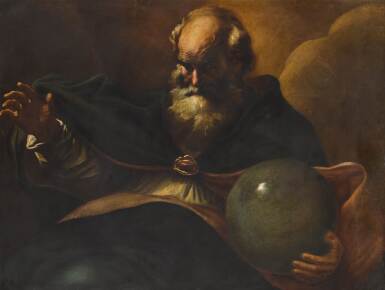Old Master & 19th Century Paintings
Old Master & 19th Century Paintings

Property from Ollerton Grange: an Interior by Robert Kime
Giovan Battista Beinaschi
God the Father
No reserve
Lot Closed
April 10, 11:27 AM GMT
Estimate
5,000 - 7,000 GBP
Lot Details
Description
Property from Ollerton Grange: an Interior by Robert Kime
Giovan Battista Beinaschi
Fossano c. 1634–1688 Naples
God the Father
oil on canvas
unframed: 92.6 x 123.7 cm.; 36½ x 48¾ in.
framed: 104.4 x 134.9 cm.; 41⅛ x 53⅛ in.
Anonymous sale, London, Sotheby's, 24 April 2007, lot 297, for £14,400 (as follower of Giovanni Lanfranco);
Where acquired by the present owner.
The re-attribution of this painting to Giovan Battista Beinaschi constitutes an exciting addition to the artist's œuvre. God the Father appears to have been a favoured subject by Beinaschi, or perhaps a popular choice among his clientele, as attested to by the ten treatments of the theme listed in Vincenzo Pacelli and Francesco Petrucci's 2011 catalogue raisonné of the artist's work.1 The version in the Klein collection, New York, in the 1960s bears the strongest affinities with the present painting, on account of the positioning of God the Father's head and hands, as well as the inclusion of the orb on the right.2 The picture in the Forti Bernini collection, Rome, is also comparable in its inclusion of the jewelled fastening in the centre of God the Father's chest, holding his cloak together, as can also be noted in this example.3 Gianluca Forgione dated the Klein picture to circa 1680–88 and the Forti Bernini example to circa 1683, thus providing an approximate date for the present painting.4 Works from these last decades of Beinaschi's life are almost always characterised by strong gesture and a theatricality typical of the Baroque style.
Beinaschi began his artistic career in Turin, under the protection of Cristina Duchessa di Savoia (1606–1663), but by 1652 he was in Rome, apprenticed to the engraver Pietro del Po (1610–1692). It was through Del Po that Beinaschi developed his own skills as an engraver, copying the frescoes by Annibale Carracci (1560–1609) in the Galleria Farnese and those by Giovanni Lanfranco (1582–1647) in the churches of Sant'Andrea della Valle and San Carlo ai Catinari. Beinaschi was particularly influenced by other Baroque painters working in Rome and Naples; namely Mattia Preti (1613–1699) and Lanfranco. Del Po provided a direct link between Beinaschi and Lanfranco for he had followed the latter from Naples to Rome, after having been his chief assistant in the church of SS. Apostoli in Naples in 1644–46 (a church whose cupola Beinaschi would fresco some forty years later). Beinaschi would have been able to see the paintings of Lanfranco, to whom De Dominici incorrectly states he was apprenticed, in Naples and Rome, though he probably first came into contact with the master's work in Parma, where Beinaschi is presumed to have gone as a young man.
Lanfranco's influence can be particularly felt in Beinaschi's God the Father compositions, including this example, owing to the parallels between this group of works and the older artist's well-known treatment of the subject now in the Pinacoteca Comunale, Fermo.5 Similarities can also be drawn with a picture by Pier Francesco Mola (1612–1666) in the Koelliker collection, Milan.6
We are grateful to Dott. Francesco Petrucci for endorsing the attribution to Beinaschi upon the examination of digital images.
1 V. Pacelli and F. Petrucci (eds), Giovan Battista Beinaschi: pittore barocco tra Roma e Napoli, Rome 2011, pp. 254–55, 298–300, 306–8, nos A26–A27, Ca13–Ca14, Ca28–Ca33.
2 Oil on canvas, no dimensions given; G. Forgione, in Pacelli and Petrucci 2011, p. 308, no. Ca33, reproduced.
3 Oil on canvas, 75.5 x 62.6 cm.; G. Forgione, in Pacelli and Petrucci 2011, p. 307, no. Ca30, reproduced. See also F. Petrucci, in Pacelli and Petrucci 2011, p. 110, reproduced in colour on p. 112.
4 G. Forgione, in Pacelli and Petrucci 2011, pp. 307–8, nos Ca33 and Ca30, both reproduced.
5 Oil on canvas, 373 x 241 cm.; E. Schleier (ed.), Giovanni Lanfranco: Un pittore barocco tra Parma, Roma e Napoli, exh. cat., Milan 2001, p. 184, under no. 42, reproduced.
6 Oil on canvas, 156 x 118 cm.; F. Petrucci, in Mola e il suo tempo, F. Petrucci (ed.), exh. cat., Milan 2005, p. 140, no. 19, reproduced in colour on p. 141 and on the front cover.
You May Also Like










